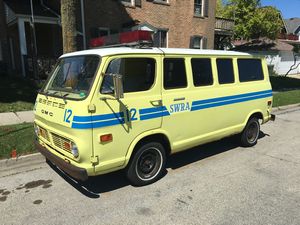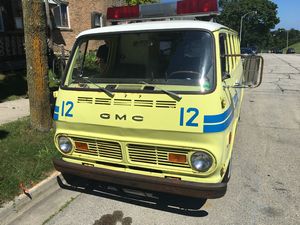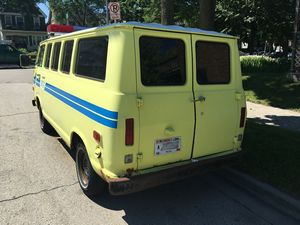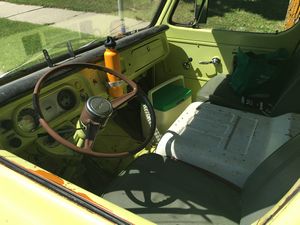















GMC Handi-Bus |
|---|
|
| Topic Navigation |
|---|
|
Wikipedia: Chevrolet Van
Page Sections History Photographs |
History
The following section is an excerpt from Wikipedia's Chevrolet Van page on 22 April 2018, text available via the Creative Commons Attribution-ShareAlike 3.0 Unported License.
The 1st generation ChevyVan refers to the first Chevrolet G-Series vans G-10 1⁄2 ton production years 1964 through 1966. General Motors saw a market for a compact van based on a modified passenger car platform to compete with the already successful Ford Econoline and Dodge A100. The 1964 ChevyVan had a cab forward design with the engine was placed in a "doghouse" between and behind the front seats. The implementation of situating the driver on top of the front axle with the engine near the front wheels is called internationally a "cab over" vehicle. Engines and brakes were sourced from the Chevy II, a more conventional compact car than Chevrolet Corvair. The forward engine design allowed a flat rear floor with low deck heights in the rear of the van for loading/unloading cargo. This model was also sold by GMC as Handi-Van. The 1st Gen vans were available in only the short 90-inch wheelbase and were only sold with the standard 90 hp 153-cubic-inch straight-4 or Chevrolet Straight-6 engine. A first gen is quickly identified by its single piece flat windshield glass. The first 1964 ChevyVan was originally marketed and sold as a panel van for purely utilitarian purposes. Windows were available as an option, but were simply cut into the sides from the factory. In 1965, Chevy added Sportvan which featured windows actually integrated into the body. GMC marketed their window van as Handi-Bus. Air conditioning, power steering and power brakes were not available in the 1st generation vans.
For 1965, the van remained largely unchanged. The grille openings were widened, and received one additional slot just above the bumper to increase cooling. Seat belts were added. The exciting news for the 1965 model year was the introduction of the Chevy Sportvan and GMC Handi-Bus.
In 1967, ChevyVan received a major facelift, including moving the headlights down to a new redesigned grille, larger, rectangular tail lights and a curved windshield. The forward control cab design was retained, but the doghouse was lengthened, widened and slightly relocated in order to fit an optional Chevrolet Small-Block engine. Engine cooling was improved with the addition of an optional larger cross-flow type radiator and a redesigned front which included a low-profile tunnel allowing more fresh air to the radiator. The 2nd gen vans were available in either the 90-inch or the longer 108-inch wheelbase. Power steering and "conventional" air conditioning (with dash vents & controls) were never available on the second-generation van.
 |
Second Generation Photo ©2017 Bill Crittenden View photo of Second Generation GMC Handi-Bus - 3.8MB |
 |
Second Generation Photo ©2017 Bill Crittenden View photo of Second Generation GMC Handi-Bus - 3.8MB |
 |
Second Generation Photo ©2017 Bill Crittenden View photo of Second Generation GMC Handi-Bus - 1.1MB |
 |
Second Generation Photo ©2017 Bill Crittenden View photo of Second Generation GMC Handi-Bus - 3.7MB |
 |
Second Generation Photo ©2017 Bill Crittenden View photo of Second Generation GMC Handi-Bus - 2.3MB |
